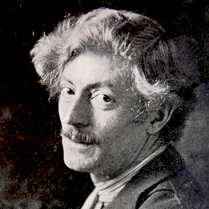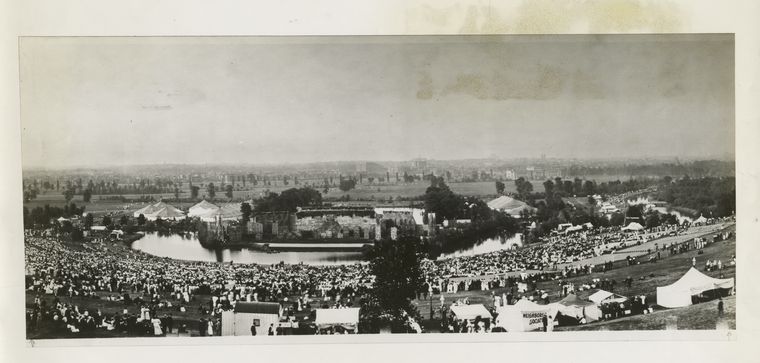Pageants and Theatrical Productions
Dawson Dawson-Watson, raised in an atmosphere of culture and refinement, grew up interacting with artists and actors of the day who were the friends of his father, John Dawson Watson and his uncle Myles Birkett Foster.
ca. 1870 – Dawson-Watson’s uncle, Myles Birkett Foster, hosted an elaborate Christmas costume ball.
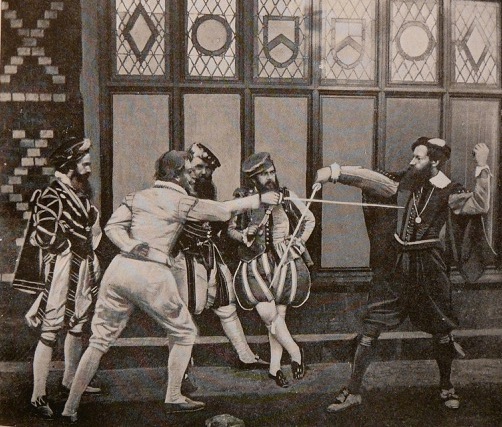
Christmas Festivities. Birket Foster and Friends in Sixteenth Century Costume.
According to Cundall (pg. 168), “The two fencing are J. D. Watson, in white, and Alfred Cooper, in black; behind the former is Edmond Evans, whilst Birket Foster and W. Lindsay Watson, leaning against the window-sill, are watching the bout.
Dawson-Watson’s father was frequently the host for dinner parties, which included his artist and actor friends. On one particular occasion, Dawson-Watson remembers an encounter with the actress Beatrice Forbes-Robertson:
On one of those evenings I was going down the flight of stairs which led to the supper room, and coming up the stairs was Beatrice Forbes-Robertson. I said, Have you had anything to eat? and her reply, in rather a soulful voice was Yes, thank you, I have just eaten four rose leaves! You see, the whole feeling of the time was the adoration of the beautiful, perfectly sincere adoration in many cases, but which always sounded like a pose!
ca. 1871 – During the time that John Dawson Watson was living in Northumberland close to Cullercoats, he organized a production of Shakespeare’s Twelfth Night. The play was held to support refugees emigrating into England. Dawson-Watson recalls the event in his memoir:
He [John Dawson Watson] provided the funds for everything that had to be purchased, and the material was the most expensive that could be bought. As he was a great authority on costume he took charge of that part of it and cut out every one of the costumes himself. All of the sewing was done in our house by a group of women. It was splendidly put on at the Theatre Royal in Newcastle and a sum of £800 about $5000 turned over to the relief committee.
1879–80 – Dawson-Watson resided for six weeks in Buckingham Street, Strand with the drama critic Fred Broughton and is introduced to some of the leading matinee idols of the day.
1881–82 – Dawson-Watson attended comic operas of Gilbert and Sullivan at the Savoy Theatre in the Strand.
1905 – The Dawson-Watsons spent the summer in Scituate, Massachusets, at which time Marion Lunt Meteyard, mother of the artist Thomas B. Meteyard, conceived the idea of having a Dante Pageant. The idea for the pageant was most likely inspired by Mrs. Meteyard’s step-uncle, Dr. Thomas Parsons, a poet and translator of Dante. The pageant was held in the field surrounding the Meteyard’s residence and studio. Dawson-Watson recalls in his memoir:
The pageant was mostly a procession across the field with small children strewing flowers in front of it; and during the playing and singing the people who were in the procession disposed themselves in picturesque groups of figures, some sitting, some standing, others reclining. It was quite a unique and fascinating thing. Meteyard, the two Goodhues, Theodora Thayer, and a lot of lesser lights took part in it.

Dante Pageant participants. Front row seated second from left: Mrs. (Dot) Dawson-Watson; seated in front of her is Edward Dawson Dawson-Watson; seated to the right of Edward Dawson is Hilda Rosiland Dawson-Watson (wearing a white costume looking to the right). Thomas Meteyard is seated second from the right.
(Dawson Dawson-Watson family archives)

Dawson-Watson and his family at the Dante Pageant in Scituate, Massachusetts.
(Dawson Dawson-Watson family archives)
1904–15 – During this period Dawson-Watson is employed as an art instructor at the St. Louis School of Fine Arts at Washington University. His summers were spent in the Missouri Ozarks painting and directing pageants. Dawson-Watson also plans, directs, stages and costumes numerous theatrical and pageant productions in St. Louis. He recalls in his memoir:
At one time I made for a theatrical organization, in the hours I was not at the Art School, four large water colors [unlocated], correct in all the details showing the major scenes in a play; 25 to 30 designs in color of costumes [unlocated], a meeting of those taking part and their friends and relatives who had to make the costumes; a lesson in pattern-cutting, instructions as to cost of materials and quantity needed; two or three days devoted to painting of the scenery and several more days to the making of the principal pieces of furniture to be used, that was one of my one-man jobs; for three successive years, that and stage directing at $200 a month, that money was earned.
Another theatrical figure who had an influence on Dawson-Watson was the acclaimed Shakespearean actor Robert B. Mantell (1854–1928) who was a close friend of the artist’s father. When the St. Louis Shakespearean Society gave a dinner in honor of Mantell and his visiting theatre company, Dawson-Watson was a guest. At the dinner, Dawson-Watson asked Mantell if he had seen John Dawson Watson’s production of As You Like It performed at the Theatre Royal in Manchester, England. The performance was a benefit production for the widow of Charles Calvert (1828-1879), a noted British Shakespearean actor. According to Dawson-Watson, Mantell remarked that he had indeed seen the performance and that it was superbly done.
During his summers in Brandsville, Dawson-Watson wrote and presented two pageants: Snow White and the Seven Wee Men (1916) and Ali Baba and the Forty Thieves (1917). According to a West Plains newspaper article, Artist’s Ozark Home Burns, the Snow White pageant had been an annual event in celebration of the closing of the peach harvest in the Brandsville-Koshkonong district. The event was usually attended by the entire countryside and held in a natural amphitheatre on the side of a hill. Dawson-Watson recalls in his memoir that the local community, “…entered with the right spirit, making their own costumes and so on.”

Photograph of Dawson-Watson (far right) directing the Snow White Pageant in Brandsville, Missouri, 1916.
(Dawson Dawson-Watson family archives)
1914 – In commemoration of the 150th anniversary of the founding of St. Louis, The Pageant and Masque of St. Louis was held in Forest Park at the end of May in 1914. Dawson-Watson wrote an article in The Mirror [ca. 1909] suggesting an idea for such a pageant. After the article appeared, Dawson-Watson was approached by John Gundlach, a prominent St. Louis citizen. They discussed the cost of presenting a city pageant and Dawson-Watson suggested an amount of $25,000. Five years later the pageant was held in front of the St. Louis Art Museum upon a vast stage that was built over the Grand Lagoon at the foot of Art Hill. The pageant was held from May 28 – 31, 1914 and was attended by over 100,000 people nightly.
Dawson-Watson noted in his memoir that the St. Louis Pageant, “…was written by Thomas Wood Stevens, and the Masque was written by Percy McKaye [MacKaye], and it was costumed by Joseph Linden Smith and it was superb.”
Dawson-Watson was on the pageant’s Advisory Committee. He also served as the Chairman of the Costumes Committee of the St. Louis Pageant Drama Association. The costumes for the pageant were selected from a competition sponsored by this association. In addition Dawson-Watson contributed to the pageant by making tests of color and sound across the lagoon.

Brochure for the St. Louis Pageant Costume Competition (1914). Dawson-Watson served as Chairman of the Costumes Committee.
(Dawson Dawson-Watson family archives)
The Miriam and Ira D. Wallach Division of Art, Prints and Photographs: Photography Collection, The New York Public Library, Pageant and Masque, Forest Park, St. Louis, Mo., May 28-31, 1914, New York Public Library Digital Collections, accessed May 20, 2020, https://digitalcollections.nypl.org/items/510d47da-6459-a3d9-e040-e00a18064a99.

J.C. (Joseph Christian) Leyendecker (1874-1951), The Pageant and Masque of St. Louis, 1914, chromolithograth, Missouri Historical Society, accessed May 20, 2020, https://collections.mohistory.org/resource:196185.

The Pageant and Masque of St. Louis, 1914, A stage was made by putting a platform over the Grand Basin in Forest Park, accessed October 1, 2022, https://news.stlpublicradio.org/arts/2014-07-02/forget-about-the-250th-birthday-historical-photos-show-st-louis-celebrating-its-150th.
The Pageant and Masque of St. Louis, Official Programme, Forest Park, St. Louis, May, 1914.
1919 Oct 15-Nov 11 – Dawson-Watson directed the first Industrial Art Show in St. Louis: “Then came the first Industrial Art Show at the old Southern Hotel of which I was the art director and for which I designed the entire decorations of the front of the building and the street approach.”
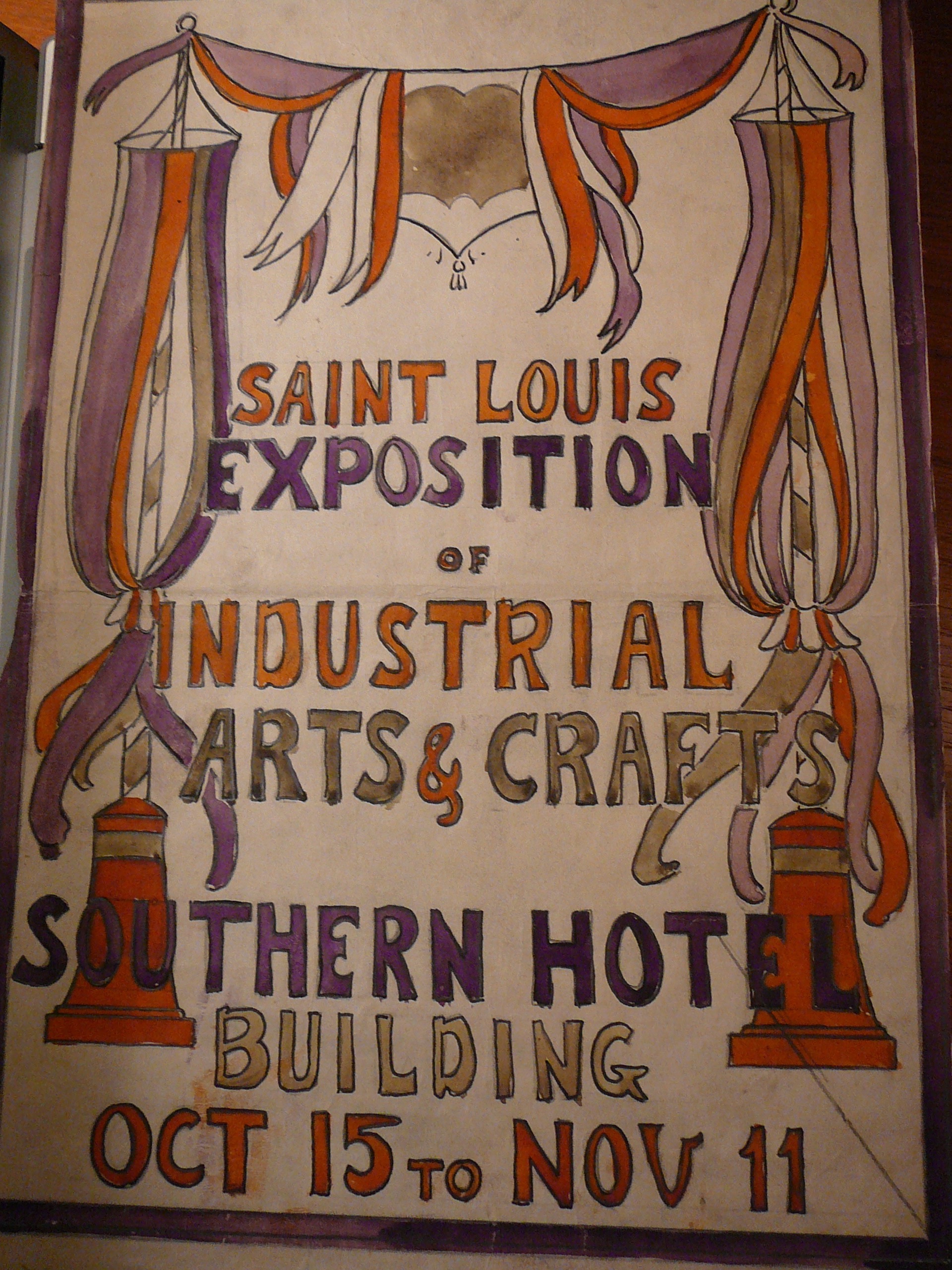
Dawson Dawson-Watson, Saint Louis Exposition of Industrial Arts & Crafts, Oct 15–Nov 11, 1919, watercolor, 12 x 15 in. (30 x 38 cm).
(Dawson Dawson-Watson family archives)
ca. 1916 – At the urgent request of one of the St. Louis Fine Art School students, Dawson-Watson arranged an Arabian Nights Ball to benefit the school’s annual scholarship fund. The student said that “the annual dramatic wind-up was in a hopeless tangle and only I [Dawson-Watson] could pull it out.” Dawson-Watson also related that his vanity was tickled and with the perfectly marvelous cooperation of the students they raised a nice little sum for the scholarship fund. Dawson-Watson arranged the program in its entirety, which included six sketches of his own devising.
1919 – When the city of St. Louis began its preparations for the return of Missouri troops from World War I, Dawson-Watson was contacted by the St. Louis architect and painter, Thomas Barnett who had designed a “Court of Honor” which ran for six city blocks, and Barnett subsequently hired Dawson-Watson to oversee the street decorations for the celebration.
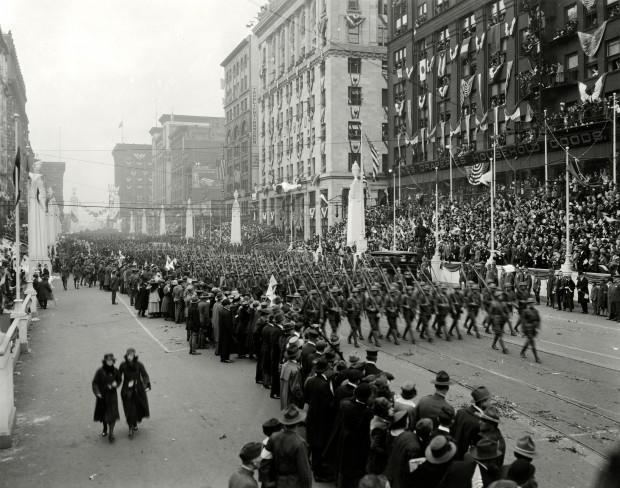
View of the 138th Infantry Regiment’s homecoming parade on May 9, 1919, looking north on today’s Tucker Boulevard, accessed October 5, 2022, https://www.stltoday.com/news/archives/when-the-doughboys-came-home-st-louis-threw-a-homecoming-party-for-the-ages/article_1d89ae89-e95d-5434-8e83-1480d3125c0b.html.
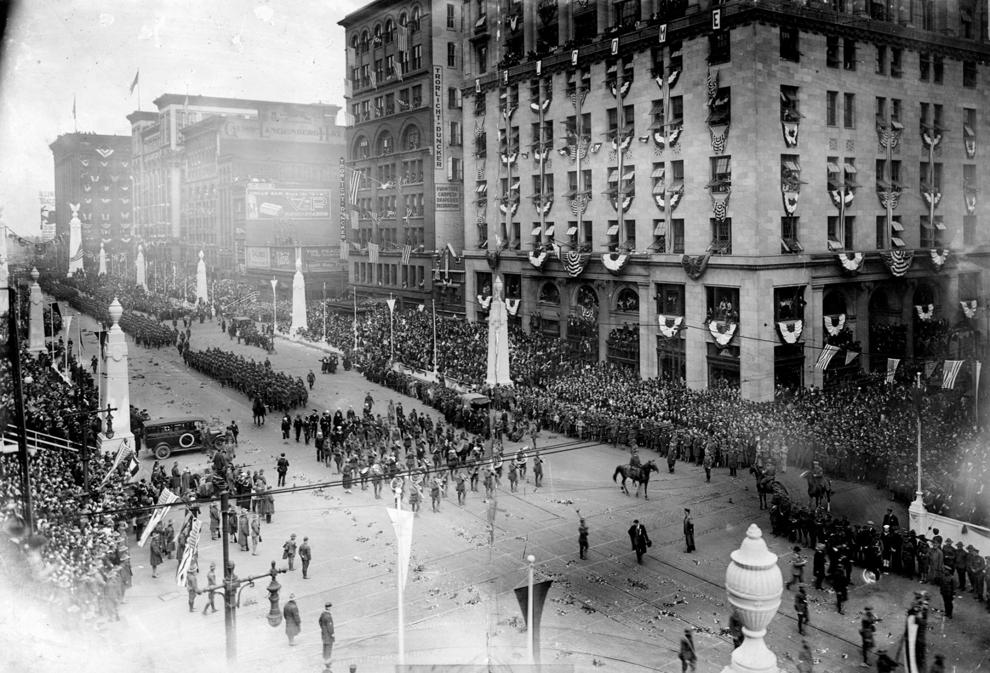
St. Louis’ own 138th Infantry Regiment returns from World War I with a parade through the city on May 9, 1919. The formation is marching south on 12th Street (now Tucker Boulevard) at Olive Street. Just out of view to the left was the Shubert-Jefferson Theater in the Union Electric Co. building, where organizers of the American Legion were holding their first meeting in America on the same day. The city had erected the pillars to make 12th Street a “hall of honor” for veterans returning from the Great War, St. Louis Post-Dispatch, accessed October 5, 2022, https://www.stltoday.com/news/archives/when-the-doughboys-came-home-st-louis-threw-a-homecoming-party-for-the-ages/article_1d89ae89-e95d-5434-8e83-1480d3125c0b.html.
1921 – During August 8-20, 1921, Missouri celebrated its 100th anniversary by staging the Missouri Centennial Exposition at the State Fair in Sedalia. The Exposition was directed by Thomas Wood Stevens with Dawson-Watson serving as the Chairman of Stage and Decorations. In his memoir, Dawson-Watson stated that his duties also included working on the Twelfth Street Pageant, “The Coming of Lafayette” [Lafayette Pageant Ball and French Fete] which was carried out under the auspices of the St. Louis Art League. The pageant was held on October 5, 1921.

Vinnorma Shaw (1890-1949), Missouri Centennial Exposition and State Fair poster, August 8-20, 1921, (BROA S28mis2, BROA S28mis2.jpeg), The State Historical Society of Missouri, Missouri Bicentennial and Centennial Collection, accessed May 23, 2020, https://digital.shsmo.org/digital/collection/p17228coll11/id/123/.

Cover, Lafayette Pageant, Ball and French Fete brochure, 1921.
(Dawson Dawson-Watson family archives)
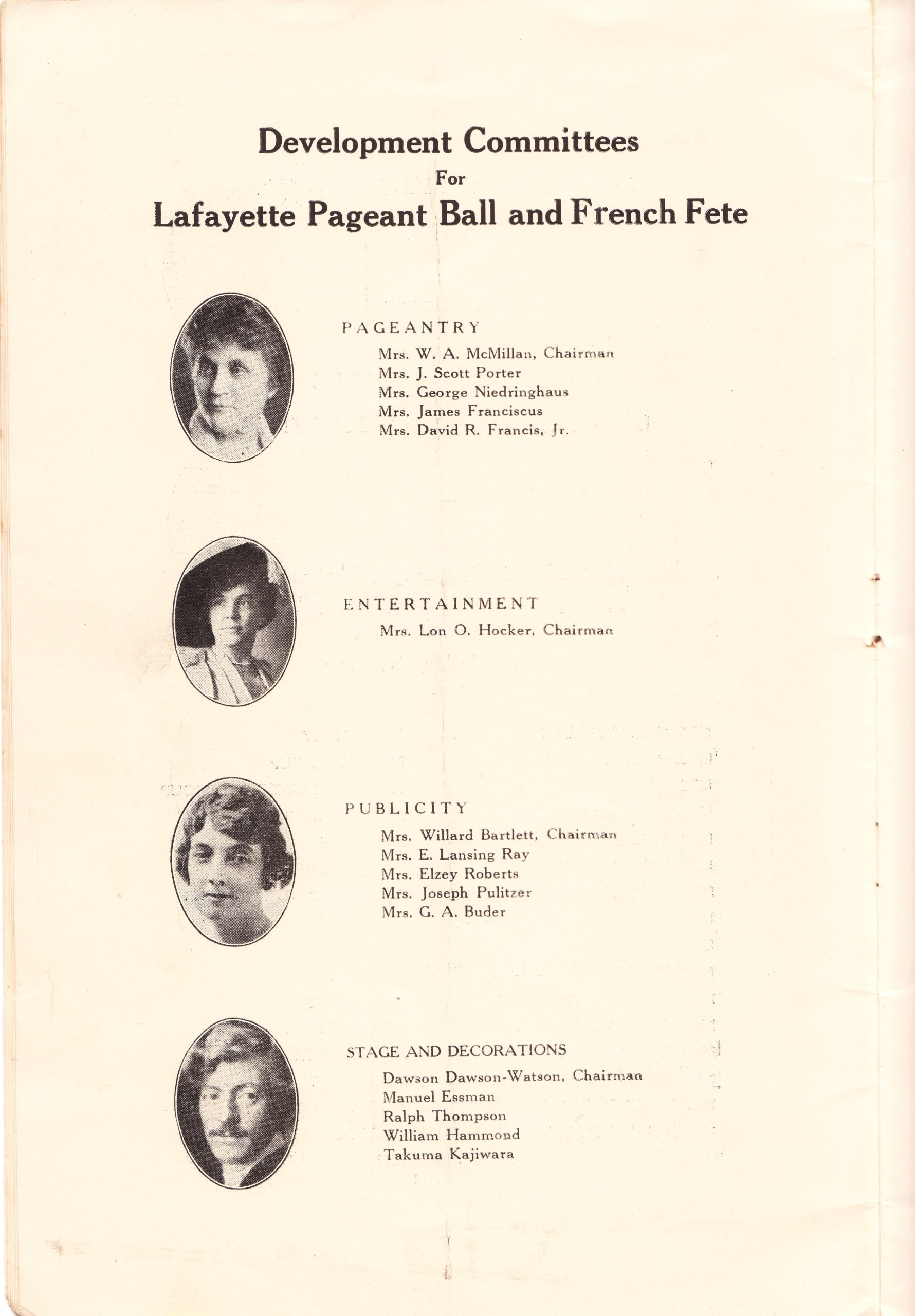
Lafayette Ball and French Fete brochure, 1921. Dawson-Watson served as Chairman of the Stage and Decorations Committee.
(Dawson Dawson-Watson family archives)
1923 – On May 23, Dawson-Watson embarked on an extended trip through the Southwest. After stopping to paint in Zuni, New Mexico, and in the Grand Canyon of Arizona, he went on to Hollywood, where he met the actor Douglas Fairbanks, who was in the midst of filming The Thief of Bagdad (released in 1924). Dawson-Watson spent over three months in Hollywood subsequently making oil paintings and pencil sketches depicting scenes from the film, some of which featured Fairbanks himself. During his visit to Los Angeles Dawson-Watson also portrayed the silent film star Mary Pickford as she appeared in Rosita Sings (released in 1923).
1923 – Dawson Dawson Watson, well known St. Louis artist, who is claimed by the people of the Howell County Ozarks as their very own artist, is to be honored with a reception and tea to be given in St. Louis tomorrow night. The reception will be given at Healey’s where Mr. Watson is exhibiting a unique collection of paintings done on a recent trip which he made through the Grand Canyon and to Hollywood, Cal., the collection including paintings of Douglas Fairbanks, Mary Pickford and other famous movie stars.
According to the St. Louis papers, there are two colorful scenes from the canyon and an extensive collection of paintings made while the actors were on location in Douglas Fairbanks’ new spectacle, “The Thief from Bagdad,” which is now being filmed for release some time next year. One painting, entitled “Rosita Sings,” was made of Mary Pickford when she took part in the film “Rosita, the Street Singer,” now showing in New York City.
Several of the portraits show Douglas Fairbanks and other characters in the film just as they appeared on location and are interesting in the fact that Watson made the trip to Hollywood to secure these paintings and many pencil sketches of the film artist at work, not from a commercial point of view but as a new field for artistic endeavor.
Of the many paintings and sketches which were made on the trip Watson has six of his paintings on exhibition at the Stendahl galleries in the Ambassador hotel in Los Angeles, Cal., and another in the Home Exhibit at Pittsfield, Mass., at this time.
The exhibit now on view at Healey’s is known as “The New Arabian Nights Collection.”
Mr. Watson was the first artist to paint the beauties of the Howell county Ozarks. He and his family came to Howell county several years ago and spent the summer at Brandsville, where he made a number of paintings of peach harvest scenes in the famous peach village. Later they spent several summers in West Plains and at Brandsville, during which time he painted many scenes at Grand Gulf and various other beauty spots in this section. While here he also wrote a fairy pageant and an Arabian Nights pageant, which he staged in a natural amphitheater in a glen at Brandsville.
During their visits to the Ozarks the Watson’s made many warm friends among the people here. Their son, Dawson Dawson Watson, Jr., better known as “Don,” was married while the family resided here to Miss Marie Sawyer, daughter of Mr. and Mrs. W. F. Sawyer, formerly of West Plains, but now of Willow Springs.
Pageants are one of the artist’s pet hobbies and he has directed some of the largest and most spectacular ones ever given in St. Louis. He was at one time head of the art department in Washington University there, and is widely known in art circles of the city. [1]
June 1928 – Dawson-Watson served as a judge in the third annual International Pageant of Pulchritude. The jury of selection also included the artists Harry Tuthill, Albert Reiker, W.V. Guinness, Jack Patton, and John Held Jr., as well as the editor and advertising executive E.H. McReynolds.
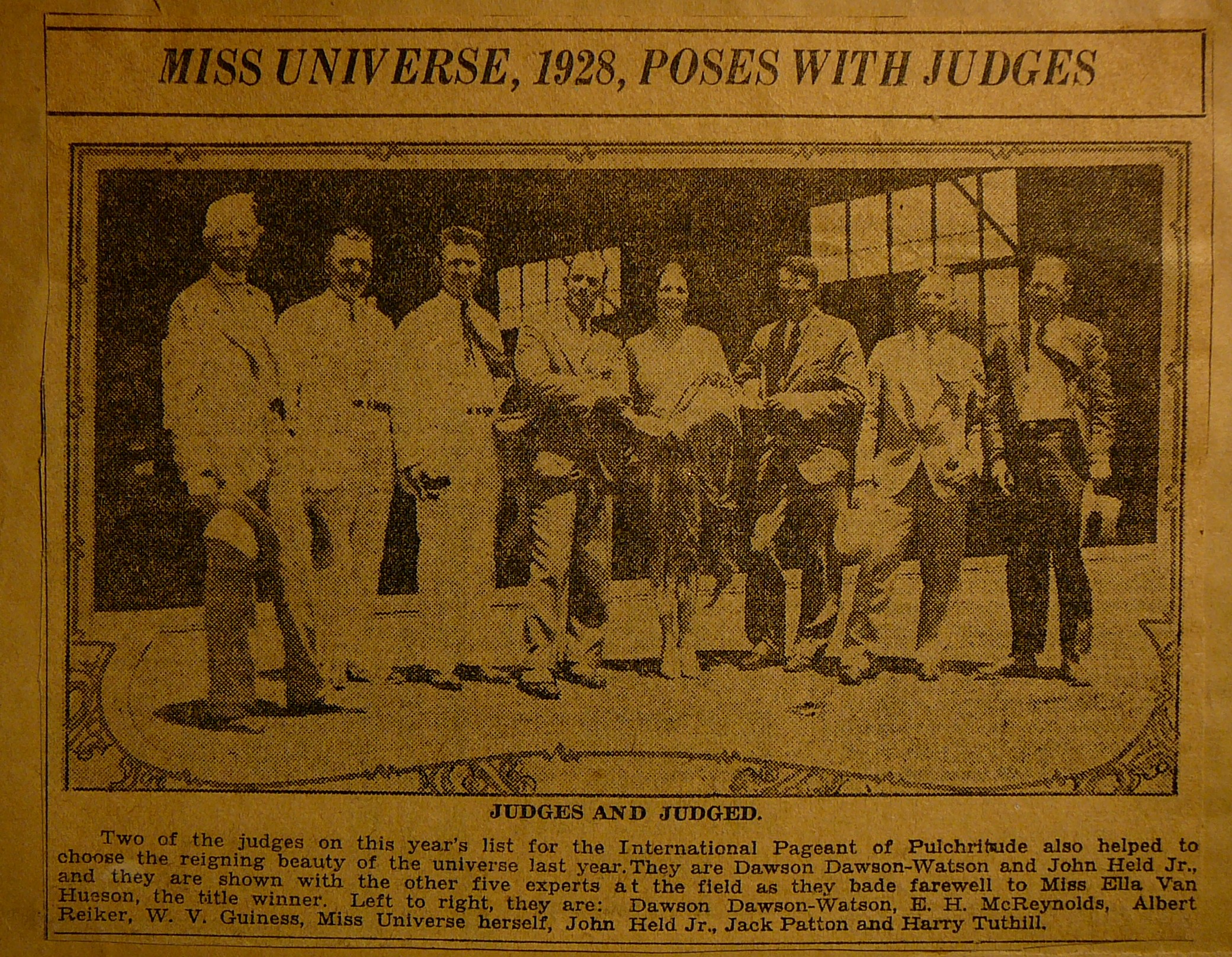
Miss Universe Ella Van Husson poses with judges at the International Pageant of Pulchritude, 1928. Dawson-Watson is first from the left. Unknown publication.
(Dawson Dawson-Watson family archives)
June 1929 – Dawson-Watson officiated at both the Miss United States Pageant and the fourth International Pageant of Pulchritude, along with a panel of judges that included the movie director King Vidor, artists Rolla Taylor, McClelland Barclay, John Held Jr., the portrait photographer Nikolas Muray, and the art editor Max Herzberg. The latter event attracted media attention from around the world as the Austrian-born contestant, Lisl Goldarbeiter, was the first non-American to win the title. Upon receiving her award, Goldarbeiter posed for Dawson-Watson, who captured her allure in a watercolor portrait completed in forty minutes.
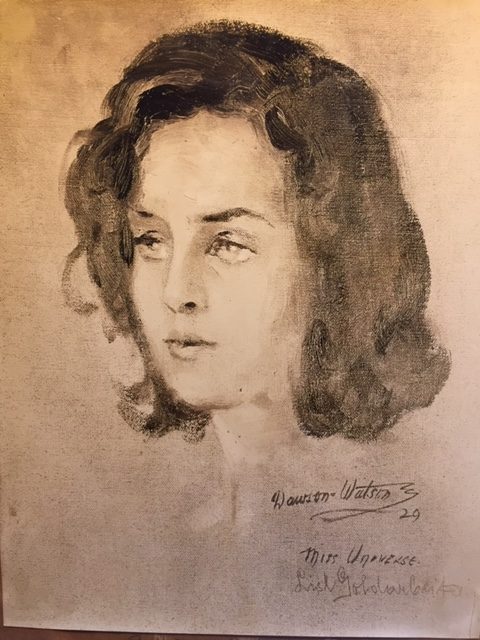
Dawson Dawson-Watson, Miss Universe (1929; watercolor on paper, 14 x 16 in., present location unknown), W.1929.1. Photograph: Dawson Dawson-Watson family archives.
Inscribed lower right under signature: Miss Universe/and signed by Lisl Goldarbeiter.
Dawson Dawson-Watson, “Things Remembered,” manuscript memoir, Dawson-Watson family archives.

